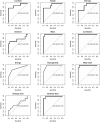Second-order grey-scale texture analysis of pleural ultrasound images to differentiate acute respiratory distress syndrome and cardiogenic pulmonary edema
- PMID: 33313979
- PMCID: PMC8894303
- DOI: 10.1007/s10877-020-00629-1
Second-order grey-scale texture analysis of pleural ultrasound images to differentiate acute respiratory distress syndrome and cardiogenic pulmonary edema
Abstract
Discriminating acute respiratory distress syndrome (ARDS) from acute cardiogenic pulmonary edema (CPE) may be challenging in critically ill patients. Aim of this study was to investigate if gray-level co-occurrence matrix (GLCM) analysis of lung ultrasound (LUS) images can differentiate ARDS from CPE. The study population consisted of critically ill patients admitted to intensive care unit (ICU) with acute respiratory failure and submitted to LUS and extravascular lung water monitoring, and of a healthy control group (HCG). A digital analysis of pleural line and subpleural space, based on the GLCM with second order statistical texture analysis, was tested. We prospectively evaluated 47 subjects: 16 with a clinical diagnosis of CPE, 8 of ARDS, and 23 healthy subjects. By comparing ARDS and CPE patients' subgroups with HCG, the one-way ANOVA models found a statistical significance in 9 out of 11 GLCM textural features. Post-hoc pairwise comparisons found statistical significance within each matrix feature for ARDS vs. CPE and CPE vs. HCG (P ≤ 0.001 for all). For ARDS vs. HCG a statistical significance occurred only in two matrix features (correlation: P = 0.005; homogeneity: P = 0.048). The quantitative method proposed has shown high diagnostic accuracy in differentiating normal lung from ARDS or CPE, and good diagnostic accuracy in differentiating CPE and ARDS. Gray-level co-occurrence matrix analysis of LUS images has the potential to aid pulmonary edemas differential diagnosis.
Keywords: Acute respiratory failure; Artificial intelligence; Computer aided diagnosis; Heart failure; Lung ultrasonography; Quantitative lung ultrasonography.
© 2020. The Author(s).
Conflict of interest statement
The authors declare that they have no competing interests with the subject of the article. Claudia Brusasco has no conflict of interest; Gregorio Santori: has no conflict of interest; Guido Tavazzi received fees for lectures by GE Healthcare, outside the present work; Gabriele Via has no conflict of interest; Chiara Robba has no conflict of interest; Luna Gargani received consultancy fees from GE Healthcare and Philips Healthcare; Francesco Mojoli received fees for lectures from GE Healthcare, Hamilton Medical, and SEDA SpA, outside the present work; Silvia Mongodi received fees for lectures from GE Healthcare, outside the present work; Elisa Bruzzo has no conflict of interest; Rosella Trò has no conflict of interest; Patrizia Boccacci has no conflict of interest; Alessandro Isirdi has no conflict of interest; Francesco Forfori has no conflict of interest; Francesco Corradi has no conflict of interest;
Figures


References
-
- ARDS Definition Task Force. Ranieri VM, Rubenfeld GD, Thompson BT, Ferguson ND, Caldwell E, et al. Acute respiratory distress syndrome: the Berlin definition. JAMA. 2012;307:2526–2533. - PubMed
MeSH terms
LinkOut - more resources
Full Text Sources
Medical
Research Materials
Miscellaneous

